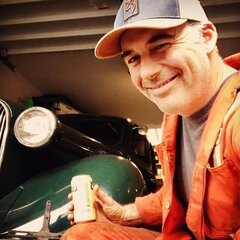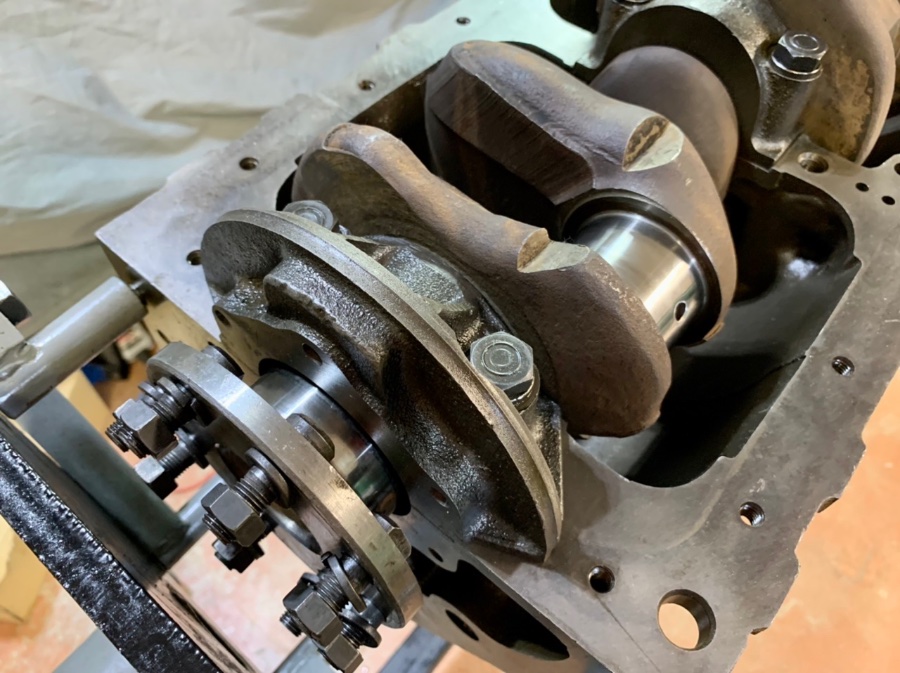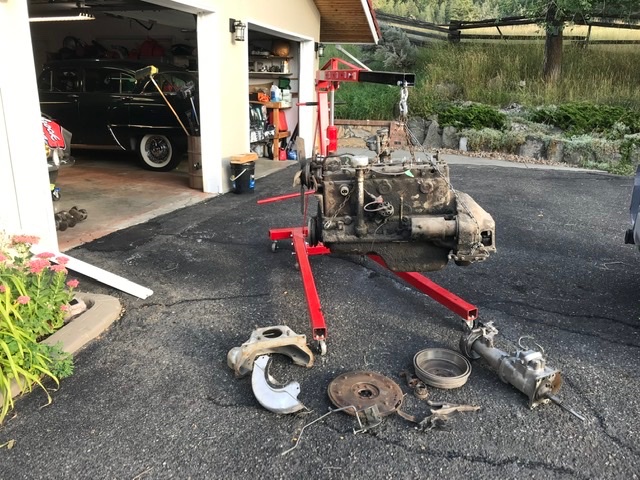-
Posts
3,462 -
Joined
-
Last visited
-
Days Won
193
Content Type
Links Directory
Profiles
Articles
Forums
Downloads
Store
Gallery
Blogs
Events
Everything posted by keithb7
-
Aha! I Kept digging. I Found this photo I took about 1.5 years ago. My images above are incorrect. The Notch cut in the bolt head contacts a groove cut in flywheel. This Stops it from from turning while torquing down. As installed above, that can’t happen. Will twist when attempting to torque. Taking them back out…☺️
-
I’m thinking like this? Crank is in, preliminary torqued. Spins nice! Headed out now for some more Plasti-gage. Checking mains clearance next. Mains were cut down 0.010
-
I thought maybe, I could do it without starting a new thread. Not so. During disassembly of my engine I took many photos along the way. I did not take every possible photo. I took the engine apart in November 2020. Here I am 11 months later. Flywheel mounting bolts to crank. Do I have it right as seen in the photo here? Bolts inserted at seal side of flange. Or do the bolts go in from the flywheel side? Nuts at the crank seal side?
-
I have no proof of product nor experience with Pertronix. I can say that I have absolutely no interest in pulling points to install any type of breaker less system in my old Mopars. My points are still reliable and work very well. I understand points and the condenser. The ignition system. I can troubleshoot and fix it roadside if needed. The ignition system in both my old Mopars is currently 83 years old and counting. For me? No way. No how. No Breakerless ignition.
-
Full disclosure. This is in Saskatchewan, Canada. I am in Canada but it’s a pretty big country. I’ve never seen these guys at the local coffee shop. Lol. To each their own yet I tend to think this one deserves to be salvaged as original. Just my opinion. Hoping someone steps up with an unsolicited offer to take it home.
-
I read an interesting article recently about flathead tappet clearances. Basically you start out with a cold engine. Initially the block heats up quicker. It expands. Tappet Clearance increases. Then rest of the valve train eventually heats up. Exhaust Valve stems elongate. Valve clearances tighten up again. Valves are closed for about 2/3 of the time the engine is running. Open for about 1/3 of the time. In 1 hour of driving time, valves are open for 20 mins, closed for 40 mins. Some interesting perspective.
-
In general expect to pay more for a quality built tool such as Mac or Snap-On. Craftsman/Sears brand will attract a lower sell price. Yet probably get the job done just fine. I had no problem spending $50 to $75 for a quality dwell tool too help keep my old cars running reliably. Doing all your own maintenance and repairs? You are already saving lots of money on hourly shop labor costs. You may want to spoil yourself a little and buy quality tools. To me, totally worth it.
-
Use my dwell meter a couple of times per year, per car. Tune up in the spring. Checking for something or other mid season. It’s good tool to own in my experience. You can eliminate one possibility when troubleshooting symptoms. I own a Snap-on model MT-816B. It reads RPM and dwell. 6V is no problem. As long as it is hooked up before I start the engine. If hooked up after engine is running RPM won’t read RPM for some reason. I suspect it’s a 6V related issue.
-
It’s thanksgiving in ands this weekend. Hope you all see your friends and family and have some great turkey together! We headed out camping. We had an epic traditional turkey dinner this afternoon. About As good as it gets. With our friends and family. We’re fortunate and grateful.
- 1 reply
-
- 3
-

-
Great car. Nice find. Especially when close by. Practically right in your back yard. Is this your first old flathead Mopar? You’ll have a ton of fun with it. If it’s all new to you, and you want to learn and perform your own maintenance and repairs these old cars are perfect! Simple. Easy to work on. Basic stuff compared to today’s standards. My journey since acquiring my first old Mopar has been fantastic. A wonderful new chapter in my life. Extremely rewarding and fun.
-
I made this tool. It works very well.
-
Some cylinder heads have a little bulge at the front of the head. There is a port in there for water pump by-pass routing. Other heads did not have this feature cast into the head.
-
Aaron I have had luck obtaining leads through several sources. I get my car out cruising a lot. Local unorganized weekly car meets. I’ve met a few guys there with old Mopar parts “out in the back behind their shed” sort of stuff. Been sitting for years. People come up to me to talk about my old car. Leads appear. Join a local vintage car club. Members will learn of your keen interest in getting your old car fixed up. Stuff starts to be presented to you. Members offering parts and or cars. Go to regional car shows. Speak to the flathead Mopar guys. Network. Get to know them and their cars a little. Ask about spare parts or car leads. Keep en eye on Kijiji. Set up searches so you are notified when parts or cars are listed for sale. Keep a keen eye on regional Facebook market place ads. Again set up and search key words and get notifications. “Flathead” is a good key search word for finding old Mopars and parts. This source is a big one. Facebook is painful, but many sellers list cars and parts on there. When driving anywhere, keep looking. You’ll sometimes see them laying in waste beside a barn or parked in fields. Rotting. You’ll definitely find guys dreaming of big dollar signs. Trying to sell old Mopar cars and parts for big bucks. I’ll present offers to them, if they snap back sharply I just move on. They made tons and tons of these cars. There are many sitting in fields rotting. These Mopars are not early flathead Ford Coupes. There’s no need to pay through the nose for spare parts or cars. If you are patient…. If you are in a hurry, yes expect to spend a lot more. For encouragement here are a couple of loads I brought home.
-
I saw this photo on-line. It caught my attention. There is a lot of similarities between this unknown car and my ‘38 Chrysler. Does anyone know car this is? Make, year, model? Big hood. Straight 8 likely?
-
When it comes to carbs I like to think about air and fuel leaks. Vacuum is created as the piston drops in its bore. The rushing path of incoming air is to be controlled and directed exactly where it is needed inside the carb. Through several passages. Large and tiny. Sandwiched pieces of the carb body with tiny orifIces are bolted together. Gasket material between them to seal them all together. The vacuum is routed specifically through many passages. Some passages accommodate moving air. Some moving fuel. A concoction of parts all working together, that can work quite well to meter fuel delivery at various engine loads and rpm’s. However vacuum passages may develop leaks. Gaskets do dry up. Then surrounding ambient air may be drawn into the carb where it should not. Then the very design of the carb is wasted. Precise control of incoming air and fuel is lost. Fuel passages may also develop leaks. Scale or sediment in the fuel system may plug up metered fuel orifices. Obstructing precise fuel flow. To me, a carb is a fascinating piece of engineering. By comparison fuel injection, although efficient, is boring in my opinion. Engineers spent a ton of time, over many decades, dialing-in carburetors. Many a late night was spent at the lab directing steam and probably smoke thru carbs to understand them. To tweak them. Walter was quite impressed with what was going on over at Ball & Ball. I believe he sent his engineers there to work with B&B (father & son) to further study and develop carbs. Not too long after, I believe Walter acquired B&B? Did it fall under the Chrysler umbrella? Somehow they were pretty close in carb development. What an exciting time.
-
Hope to get to Hershey someday. Sounds like a lot of fun for any old car lover.
-
@Aaron Mac welcome fellow Canuck. I am in BC. There are numerous Canadians on here. I got into old Mopars about 5 years ago. In that time I have been keeping an eye out for local used parts or cars. I've amassed more than I imagined I would. Lots of engine, powertrain parts. I have spare nose cones (front rad enclosures) for both of my '38 cars. Some spare body parts, trim. Brakes axles, diffs (3 different ratios) complete trannies, carbs, complete engines...And much more. I keep what I can store. Steel recycle the rest. Not long ago I paid $100 for a ton of parts. I pieced apart what I wanted. I recycled the rest. I got $88 for the scrap steel amount. Net cost $12 plus my time banging stuff apart. Typical wear parts? You gotta pay the piper in many instances. Getting stuff from the USA. Try and keep a running list. Maximize your order, buying several things at once. Then 1 freight bill. One-sies, two-sies here and there, the freight costs will leave you wondering how you can afford to stay in this hobby. Be patient. Scour local classifieds. If you can store stuff, buy low.
-
Are you seeing blue smoke all the time? Or mainly on deceleration down a hill, coasting? Then at the bottom of said hill when you hit the gas, it puffs blue smoke? Perhaps when you come coasting to a stop sign or a red light. Upon re-acceleration you get the blue smoke out the tail pipe? Then the blue smoke clears up after a few seconds of acceleration? These are some signs of worn valve guides or valve stems. Hooking up a vacuum gauge and monitoring needle movement may also help confirm valve guide wear. If you are burning oil all the time and it does not clean up during acceleration, the cause may likely rings/cylinder wall sealing issues. A wet/dry compression test may verify your situation. I am going through the effort of a rebuild now. I went pretty well all-in. All new parts. except block, head, rods and crank. New camshaft, valves, guides, tappets, all bearings, pistons & rings, water pump, oil pump, timing gears and chain, rebuilt generator, rebuilt rad last summer, all new seals and gaskets. All machining done. It's a lot of effort to go back in. I figure I am this far in, I'm doing all wearing parts. All back to stock specs. No modifications. Stock worked for 83 years. It'll go another 83, if we can still get gasoline.
-
Well done, you are a loyal friend. You found the right spot coming here. Welcome, from Canada.
-
In many examples 25" long Desoto and Chrysler engines have been installed in vehicles that originally had 23 ½" engines. It does require some modifications. Up here in Canada, I believe from about mid-1938 on, all blocks in the Canadian built and domestic sold Mopars were 25" long blocks. They played with bores and strokes to take the same block all the way down to a 218. All the way up to a 265. Suggest you do your research on any 25" long block one may acquire. The 25" 218 is a very different engine than the 218 in the 23 ½" length block. I cannot say with certainty that the same blocks were used in Canadian built Mopars, destined for commonwealth countries.
-
Based on what I have seen, yours looks pretty typical of an engine running with non-detergent oil. My suggestion is don't be switching over to modern detergent oil without doing your research and needed clean up. You may want to pull the oil pan and clean it out sooner than later. Looks like possibly new valve cover gaskets were on the to-do list in 1975. Yet for some reason got deferred to the new owner.
-

48 DeSoto Removing hog's head off the diff. to drain. Any warnings!
keithb7 replied to MarcDeSoto's topic in P15-D24 Forum
This may help with the Hog's Head? -

48 DeSoto Removing hog's head off the diff. to drain. Any warnings!
keithb7 replied to MarcDeSoto's topic in P15-D24 Forum
WT heck is a Hog's Head? Sorry, never heard that term for a car part before. Do I have one? If I do, should I self isolate in the basement for 10 days? -

Buying a 6 volt battery soon for my 48 DeSoto
keithb7 replied to MarcDeSoto's topic in P15-D24 Forum
Re trickle charging. It should be noted that modern Digital Chargers often cannot charge a completely stone dead battery. They need to read some residual voltage on the battery before they can start charging it. I literally have had to take my old 6V 1amp analog charger with a transformer in it, (from 1997) to charge up a dead battery. Then when I put the modern digital charger on it, it would then work and charge it. Initially the digital charger would not work. -

Video of 1955 Plymouth being built on the line
keithb7 replied to plymouthcranbrook's topic in P15-D24 Forum
I enjoyed that video. Thanks. Times sure have changed.









